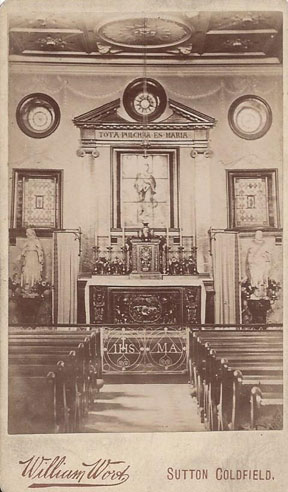Community - St John Henry Newman
St JH Newman and Maryvale's Heritage
St JH Newman and Maryvale's Heritage

Rev Dr Guy Nicholls' Sermon on Newman and Maryvale at
Thanksgiving Mass for the Canonisation of St JH Newman (February 2020)
St John Henry Newman was received into the Catholic Church by Blessed Dominic Barberi on October 9th. 1845 at Littlemore near Oxford, where he had retired from Anglican ministry with his small group of friends. From early in 1844 he had been working on his ‘Essay on the Development of Christian Doctrine’, which was to mark the last stages of his spiritual journey to Rome. Bishop Nicholas Wiseman, then the auxiliary bishop of the Midland District, had closely followed the progress of the Oxford converts, and after their reception into the Church he offered them Old Oscott house, in the country four miles from Birmingham, which had been used as a school since the seminarians had moved to the New Oscott College in 1838. Bishop Wiseman confirmed Newman at Oscott College on 1st November 1845, and at this time he stayed at Old Oscott from 31st. October to 3rd. November. On Christmas Eve 1845 Newman wrote to his friend Henry Wilberforce describing his new home. He said it would accommodate twenty to thirty people, and there was a chapel, kitchen garden, and bake house and a brew house. He finally moved into Old Oscott on Monday 23rd. February 1846, two days after his forty fifth birthday.
It seems that Newman took the upstairs room next to the chapel. In another letter to Wilberforce on 26th. February he said, ‘I am writing in the next room to the chapel. It is such an incomprehensible blessing to have Christ’s bodily presence in one’s house, within one’s walls, as swallows up all other privileges and destroys, or should destroy, every pain.’ That room, with its window looking down into the chapel, is still used for guests and students who are staying at Maryvale. It was about this time that Newman first renamed his new home ‘Maryvale’, and his pet name for it was ‘Sancta Maria in Valle’. Newman and his companions now had the opportunity to live a Catholic life together and discern what was to be their vocation within the Catholic Church. Before leaving Littlemore Newman had written ‘if we went to Oscott, our ultimate plan would be partly to study and write, partly to educate, and partly to go about giving missions and helping the local clergy.’ Consideration was also given to the creation of a college, and to that end Bishop Wiseman sent Newman to Rome in September 1846 to study at the College of Propaganda. However the idea of the college soon proved unworkable and instead Newman began to consider Bishop Wiseman’s suggestion of founding an Oratory of St. Philip Neri in England. While Newman and one companion, Ambrose St. John were in Rome the rest of his community remained at Maryvale and Newman kept in close contact with them, even giving advice from Rome about how to deal with a dangerous fireplace.

Newman and St. John were ordained deacons on 29th May 1847 at St. John Lateran, and were ordained priests the next day. In the following months Newman received his Oratorian novitiate training, and carefully studied the history and constitutions of the Oratory, to see how they could be adapted to the English way of life. He particularly wanted the Oratory to be established in a city, and that city was to be Birmingham. Finally he was ready to return to Maryvale in December 1847, bringing with him the papal brief establishing the first English Oratory in Birmingham.
After a time of prayer and preparation Newman’s community gathered on the evening of 1st February 1848, the eve of the Purification of the Blessed Virgin Mary, five priests, one novice and three lay brothers; Vespers was sung and the papal brief was read and then the nine received the Oratorian habit. It was a momentous moment for Fr. John Henry Newman and for the Catholic history of England.

Two weeks later Fr Frederick Faber, who had formed a separate community of converts at Cotton Hall, North Staffordshire, came to join the Oratorians. His mission in Staffordshire had been supported by the Earl of Shrewsbury and he eventually persuaded Newman to relinquish Maryvale and move to Cotton, and so, on 31st. October 1848 Newman left Maryvale, for what turned out to be a brief stay at Cotton before moving to the old gin factory at Alcester Street in the centre of Birmingham.
The time at Maryvale was, in a sense, a watershed in Newman’s life. He and his friends found their feet in the Catholic Church, prepared for the priesthood, been ordained and founded the first English Oratorian Community. At Maryvale Newman discerned his vocation and prepared for it by prayer, study and community life; he sets the example for all who come to Maryvale today. May St John Henry Newman pray for Maryvale and its work.
Learn more about St John Henry Newman's links to Maryvale: